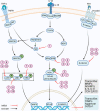Small molecules of herbal origin for osteoarthritis treatment: in vitro and in vivo evidence
- PMID: 35545776
- PMCID: PMC9092710
- DOI: 10.1186/s13075-022-02785-y
Small molecules of herbal origin for osteoarthritis treatment: in vitro and in vivo evidence
Abstract
Osteoarthritis (OA) is one of the most common musculoskeletal degenerative diseases and contributes to heavy socioeconomic burden. Current pharmacological and conventional non-pharmacological therapies aim at relieving the symptoms like pain and disability rather than modifying the underlying disease. Surgical treatment and ultimately joint replacement arthroplasty are indicated in advanced stages of OA. Since the underlying mechanisms of OA onset and progression have not been fully elucidated yet, the development of novel therapeutics to prevent, halt, or reverse the disease is laborious. Recently, small molecules of herbal origin have been reported to show potent anti-inflammatory, anti-catabolic, and anabolic effects, implying their potential for treatment of OA. Herein, the molecular mechanisms of these small molecules, their effect on physiological or pathological signaling pathways, the advancement of the extraction methods, and their potential clinical translation based on in vitro and in vivo evidence are comprehensively reviewed.
Keywords: Anabolic; Anti-catabolic; Anti-inflammatory; Compound delivery; Herbal extraction; Herbal medicine; Inflammation; Therapeutic target; Traditional Chinese medicine.
© 2022. The Author(s).
Conflict of interest statement
The authors declare that they have no competing interests.
Figures


Similar articles
-
Chinese herbal medicine might be associated with a lower rate of joint replacement in patients with osteoarthritis: A 12-year population-based matched cohort analysis.J Ethnopharmacol. 2021 Nov 15;280:114419. doi: 10.1016/j.jep.2021.114419. Epub 2021 Jul 17. J Ethnopharmacol. 2021. PMID: 34284084
-
Wogonin, a plant derived small molecule, exerts potent anti-inflammatory and chondroprotective effects through the activation of ROS/ERK/Nrf2 signaling pathways in human Osteoarthritis chondrocytes.Free Radic Biol Med. 2017 May;106:288-301. doi: 10.1016/j.freeradbiomed.2017.02.041. Epub 2017 Feb 22. Free Radic Biol Med. 2017. PMID: 28237856 Free PMC article.
-
Validation of the Key Active Ingredients and Anti-Inflammatory and Analgesic Effects of Shenjin Huoxue Mixture Against Osteoarthritis by Integrating Network Pharmacology Approach and Thin-Layer Chromatography Analysis.Drug Des Devel Ther. 2020 Mar 16;14:1145-1156. doi: 10.2147/DDDT.S243951. eCollection 2020. Drug Des Devel Ther. 2020. PMID: 32214800 Free PMC article.
-
Efficacy of some Herbal Medicines in Osteoarthritis with a Focus on Topical Agents: A Systematic Review.Curr Pharm Des. 2020;26(22):2676-2681. doi: 10.2174/1381612826666200429013728. Curr Pharm Des. 2020. PMID: 32348208
-
Dehydroepiandrosterone: Molecular mechanisms and therapeutic implications in osteoarthritis.J Steroid Biochem Mol Biol. 2018 Oct;183:27-38. doi: 10.1016/j.jsbmb.2018.05.004. Epub 2018 May 19. J Steroid Biochem Mol Biol. 2018. PMID: 29787833 Review.
Cited by
-
Notopterol mitigates IL-1β-triggered pyroptosis by blocking NLRP3 inflammasome via the JAK2/NF-kB/hsa-miR-4282 route in osteoarthritis.Heliyon. 2024 Mar 13;10(6):e28094. doi: 10.1016/j.heliyon.2024.e28094. eCollection 2024 Mar 30. Heliyon. 2024. PMID: 38532994 Free PMC article.
-
Preclinical approaches to evaluate Uncaria tomentosa bark extract loaded FDOFs using osteoarthritis models.Heliyon. 2024 Oct 2;10(19):e38813. doi: 10.1016/j.heliyon.2024.e38813. eCollection 2024 Oct 15. Heliyon. 2024. PMID: 39430457 Free PMC article.
-
Emerging Roles of Macrophage Polarization in Osteoarthritis: Mechanisms and Therapeutic Strategies.Orthop Surg. 2024 Mar;16(3):532-550. doi: 10.1111/os.13993. Epub 2024 Jan 31. Orthop Surg. 2024. PMID: 38296798 Free PMC article. Review.
-
Association between traditional Chinese Medicine and osteoarthritis outcome: A 5-year matched cohort study.Heliyon. 2024 Feb 12;10(4):e26289. doi: 10.1016/j.heliyon.2024.e26289. eCollection 2024 Feb 29. Heliyon. 2024. PMID: 38390046 Free PMC article.
-
Biased agonism of G protein-coupled receptors as a novel strategy for osteoarthritis therapy.Bone Res. 2025 May 12;13(1):52. doi: 10.1038/s41413-025-00435-y. Bone Res. 2025. PMID: 40355428 Free PMC article. Review.
References
-
- Vos T, Flaxman AD, Naghavi M, Lozano R, Michaud C, Ezzati M, Shibuya K, Salomon JA, Abdalla S, Aboyans V. Years lived with disability (YLDs) for 1160 sequelae of 289 diseases and injuries 1990–2010: a systematic analysis for the Global Burden of Disease Study 2010. Lancet. 2012;380(9859):2163–2196. - PMC - PubMed
-
- Cross M, Smith E, Hoy D, Nolte S, Ackerman I, Fransen M, Bridgett L, Williams S, Guillemin F, Hill CL. The global burden of hip and knee osteoarthritis: estimates from the Global Burden of Disease 2010 Study. Ann Rheum Dis. 2014;73(7):1323–1330. - PubMed
-
- Glyn-Jones S, Palmer AJ, Agricola R, Price AJ, Vincent TL, Weinans H, Carr AJ. Osteoarthritis. Lancet. 2015;386(9991):376–387. - PubMed
-
- Palazzo C, Nguyen C, Lefevre-Colau M-M, Rannou F, Poiraudeau S. Risk factors and burden of osteoarthritis. Ann Phys Rehabil Med. 2016;59(3):134–138. - PubMed
-
- Jordan KP, Jöud A, Bergknut C, Croft P, Edwards JJ, Peat G, Petersson IF, Turkiewicz A, Wilkie R, Englund M. International comparisons of the consultation prevalence of musculoskeletal conditions using population-based healthcare data from England and Sweden. Ann Rheum Dis. 2014;73(1):212–218. - PMC - PubMed
Publication types
MeSH terms
Substances
LinkOut - more resources
Full Text Sources
Medical

